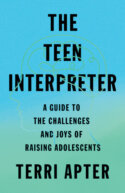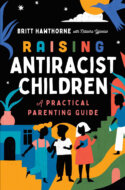Whether you’re a brand-new parent to an infant or a grizzled veteran trying to get your teens to actually talk to you, some days you can’t help but wonder if you’re doing it all wrong. These parenting books are here to help.
Good Inside

Becky Kennedy’s Good Inside: A Guide to Becoming the Parent You Want to Be is the book I wish I’d had when my kids were little. Kennedy, a psychologist, argues for finding the good inside your child when they throw a tantrum or say they hate you. To start, we need a change in perspective, seeing our kids’ behavior as clues to what they need rather than who they are. Using anecdotes from clients and her own family, Kennedy decodes behaviors (lying, squabbling, perfectionism) and offers connection strategies for each. When a parent strengthens their relationship with their child, she writes, they’ll see improved behavior and cooperation. Kennedy also shows how parents can help kids name their emotions. “The wider the range of feelings we can regulate—if we can manage the frustration, disappointment, envy, and sadness—the more space we have to cultivate happiness,” she writes. It’s a warm, good-humored book.
How to Raise an Intuitive Eater

Food is a common battleground for parents and kids at all stages. Sumner Brooks and Amee Severson’s How to Raise an Intuitive Eater: Raising the Next Generation With Food and Body Confidence link those family battles to diet culture, the messages about weight and appearance that we’re all bombarded with. They connect diet culture, including medical messaging, to shame, mental illness and negativity about food and the body. Eating disorders, the authors note, are among the mental illnesses that are hardest to treat. The good news is that kids are born intuitive eaters, their brains and bodies wired to know when and how much to eat. To build an intuitive eating family framework, the authors offer strategies such as their “add-in, pressure-off” approach: Instead of limiting foods, or labeling some foods bad and others good, focus on adding more variety. And instead of rules and commentary (“You must eat two bites!” “I can’t believe you’re not eating that!”), focus on providing the meal and letting the child decide how much to eat. Though sometimes dense, How to Raise an Intuitive Eater is a thoughtful and comprehensive resource.
The Teen Interpreter

In The Teen Interpreter: A Guide to the Challenges and Joys of Raising Adolescents, England-based psychologist and researcher Terri Apter aims to help parents engage with their teens’ struggles. “Try to see what your teen is seeing; try to understand what your teen is feeling,” Apter writes. Drawing on 35 years of studying teens and families, Apter describes some of the biggest challenges for teens and parents through the lens of teen brain development. As the teen brain remodels itself, changing dramatically, so do teens’ relationships, behavior, sense of identity and emotional responses (outbursts, rudeness, grumpy silences). Sometimes it can be tough to decipher what’s normal teen behavior and what might be mental illness, Apter notes. Throughout, The Teen Interpreter threads together research and teens’ stories, along with exercises for parents to communicate better and build stronger relationships with their teens, which in turn can help teens build resiliency through the challenging teen years and into young adulthood. It’s a clear and reassuring guide.
The Sleep-Deprived Teen

In The Sleep-Deprived Teen: Why Our Teenagers Are So Tired, and How Parents and Schools Can Help Them Thrive, journalist Lisa L. Lewis lays out why sleep matters to teens’ well-being: A lack of sleep affects their mental health, their ability to learn and play sports, and their behavior. But paradoxically, it’s tough for teens to get a good night’s sleep (8 to 10 hours) because their body clocks have shifted; they’re biologically primed to wake later in the morning and fall asleep later at night. The Sleep-Deprived Teen opens with the story of the first teen sleep studies at Stanford University, emphasizing how little experts knew about sleep and the teen brain until recently. As the parent of a teen, Lewis helped get the first law in the country passed requiring later school start times. Since then, studies have found that teens who start school later are more likely to show up at school and do better on standardized tests, and less likely to get into car crashes or trouble after school. The last chapters of Lewis’ book even offer a map for parents aiming to change school start times in their own districts.
Raising Antiracist Children

Antiracist and anti-bias educator Britt Hawthorne is also a home-schooling mom of multiracial children, and she draws on research, teaching and her own family’s experiences in Raising Antiracist Children: A Practical Parenting Guide. “Instead of viewing antiracism as a destination,” Hawthorne writes, “see it as a consistent, active practice: a lifestyle.” Part primer, part workbook with activities for different age groups, Raising Antiracist Children breaks down concepts like bias and white immunity to help parents initiate, rather than avoid, conversations on race. If you’re the parent of a child of color, the book can help you encourage their self-confidence. If you’re a white parent, the book can help you see aspects of racism you might not have seen before (for instance, the way our culture assumes white skin is the default). The book’s principles reflect a broader parenting philosophy that includes setting healthy boundaries, building community and following your child’s desire to learn. “Embracing your children’s curiosity will support them in becoming open-minded, science-driven, and empathetic,” Hawthorne writes. “Differences do not divide us, it’s our fear and unfair treatment of differences that do.”
Reading for Our Lives

The introduction to Maya Payne Smart’s Reading for Our Lives: A Literacy Action Plan From Birth to Six makes note of a quiet crisis: American basic literacy rates are weak compared to those in other industrialized nations. Parents want to raise readers, but they may not know what to do beyond reading aloud to their children before bed. Reading for Our Lives aims to change that. The book first maps out the milestones and skills—oral language, sound and print awareness, letter knowledge, phonics and spelling—that lead to reading. Smart then offers a range of strategies, games and play suggestions that help parents build those skills organically. For instance, with babies, parents can converse in a number of ways: talk, then pause to listen to their coos; ask them questions; label everyday objects for them. With older kids, parents can play “I spy” with sounds, not just colors. (“I spy something that rhymes with tike.”) Smart’s book is an empowering manual for readers and their kids.


























